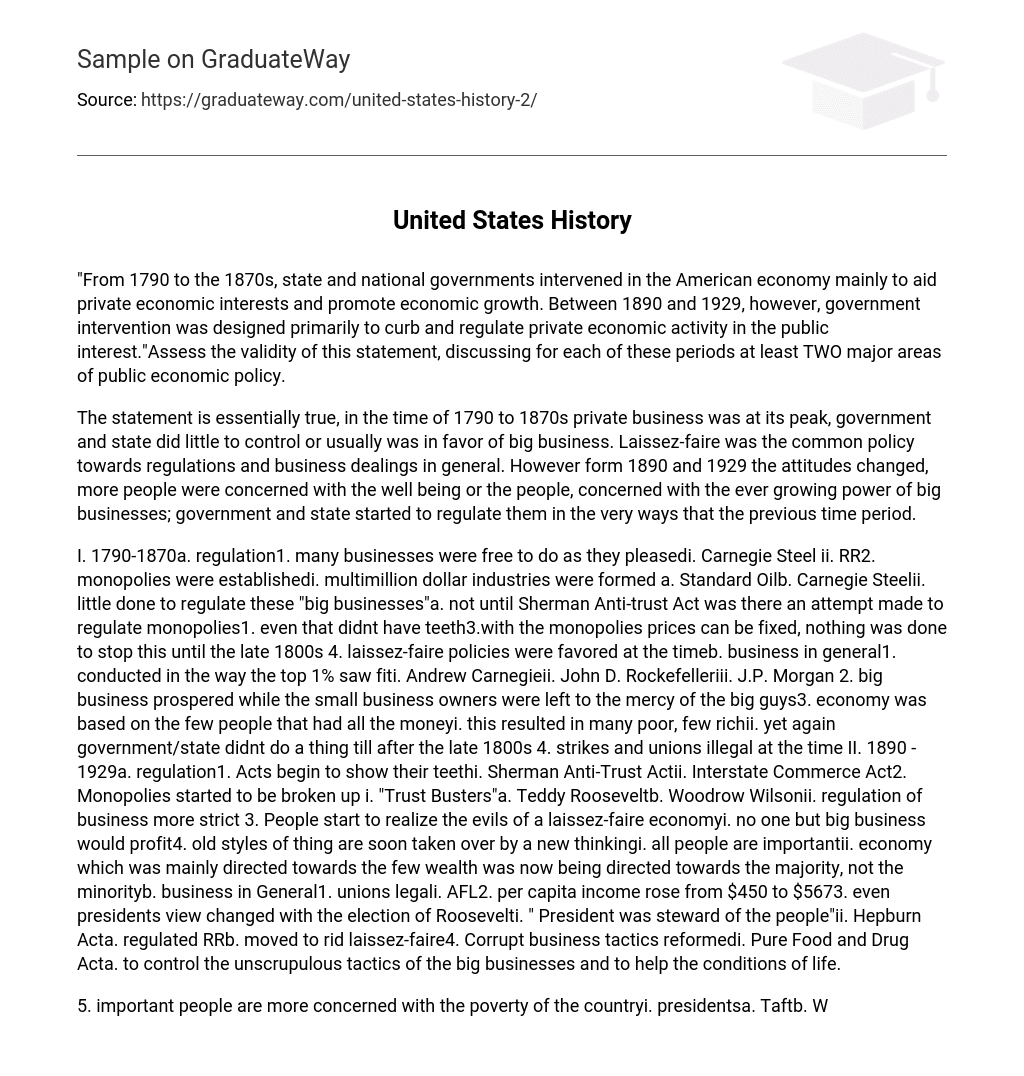“From 1790 to the 1870s, state and national governments intervened in the American economy mainly to aid private economic interests and promote economic growth. Between 1890 and 1929, however, government intervention was designed primarily to curb and regulate private economic activity in the public interest.”Assess the validity of this statement, discussing for each of these periods at least TWO major areas of public economic policy.
The statement is essentially true, in the time of 1790 to 1870s private business was at its peak, government and state did little to control or usually was in favor of big business. Laissez-faire was the common policy towards regulations and business dealings in general. However form 1890 and 1929 the attitudes changed, more people were concerned with the well being or the people, concerned with the ever growing power of big businesses; government and state started to regulate them in the very ways that the previous time period.
I. 1790-1870a. regulation1. many businesses were free to do as they pleasedi. Carnegie Steel ii. RR2. monopolies were establishedi. multimillion dollar industries were formed a. Standard Oilb. Carnegie Steelii. little done to regulate these “big businesses”a. not until Sherman Anti-trust Act was there an attempt made to regulate monopolies1. even that didnt have teeth3.with the monopolies prices can be fixed, nothing was done to stop this until the late 1800s 4. laissez-faire policies were favored at the timeb. business in general1. conducted in the way the top 1% saw fiti. Andrew Carnegieii. John D. Rockefelleriii. J.P. Morgan 2. big business prospered while the small business owners were left to the mercy of the big guys3. economy was based on the few people that had all the moneyi. this resulted in many poor, few richii. yet again government/state didnt do a thing till after the late 1800s 4. strikes and unions illegal at the time II. 1890 – 1929a. regulation1. Acts begin to show their teethi. Sherman Anti-Trust Actii. Interstate Commerce Act2. Monopolies started to be broken up i. “Trust Busters”a. Teddy Rooseveltb. Woodrow Wilsonii. regulation of business more strict 3. People start to realize the evils of a laissez-faire economyi. no one but big business would profit4. old styles of thing are soon taken over by a new thinkingi. all people are importantii. economy which was mainly directed towards the few wealth was now being directed towards the majority, not the minorityb. business in General1. unions legali. AFL2. per capita income rose from $450 to $5673. even presidents view changed with the election of Roosevelti. ” President was steward of the people”ii. Hepburn Acta. regulated RRb. moved to rid laissez-faire4. Corrupt business tactics reformedi. Pure Food and Drug Acta. to control the unscrupulous tactics of the big businesses and to help the conditions of life.
5. important people are more concerned with the poverty of the countryi. presidentsa. Taftb. Wilsonii. some richiii. writers6. policies changed towards rich being all important to a more conscious moralistic view of the people being importantIn conclusion I believe that the economic policies during 1790 to 1870 were in fact set up to aid private interests of the few wealthy in the U.S. because of the ever prevalent growing wealth in individuals such as Rockefeller and Carnegie. Monopolies and securities grew without restraint in this time period. Things fundamental to the peoples needs were neglected, such as unions and price regulations Whereas in the 1890 to 1929 policies and views were shifted to a more central focus on the public interests and monopolies were starting to be toppled by “trust busters” and laws and regulations set against them such as the Sherman Anti-trust act and the Interstate Commerce Act which were first made effective with president Roosevelt.





